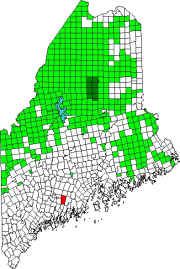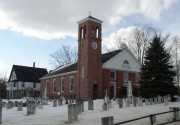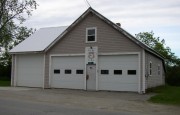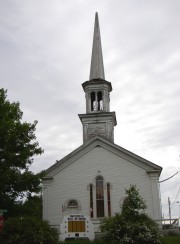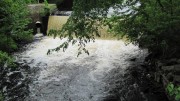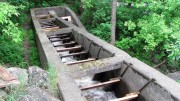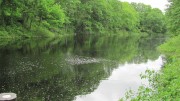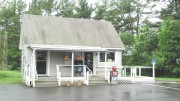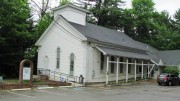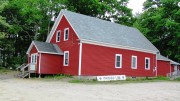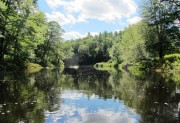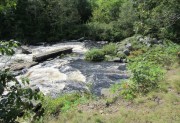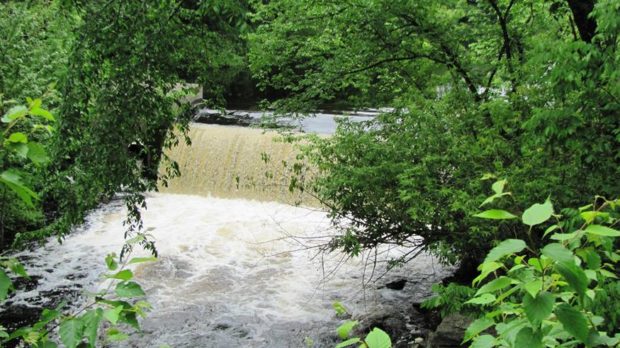
| Year | Population |
|---|---|
| 1970 | 1,131 |
| 1980 | 1,606 |
| 1990 | 1,931 |
| 2000 | 2,273 |
| 2010 | 2,300 |
| Geographic Data | |
|---|---|
| N. Latitude | 44:12:43 |
| W. Longitude | 69:36:59 |
| Maine House | District 88 |
| Maine Senate | District 13 |
| Congress | District 1 |
| Area sq. mi. | (total) 47.5 |
| Area sq. mi. | (land) 46.8 |
| Population/sq.mi. | (land) 49.2 |
| County: Lincoln
Total=land+water; Land=land only |
|
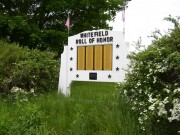 [WHITE-field] is town in Lincoln County, incorporated on June 19, 1809 from the part of Ballstown Plantation remaining after the western portion became the town of Jefferson in 1807.
[WHITE-field] is town in Lincoln County, incorporated on June 19, 1809 from the part of Ballstown Plantation remaining after the western portion became the town of Jefferson in 1807.
The town was named for a well-known itinerant minister, George Whitefield, who visited Maine in 1745.
John Ball, and a substantial number of Irish Roman Catholics, settled the area in 1770, attracted by the lumbering opportunities and the ability to ship logs down the Sheepscot River, which also provided power for the associated mills.

Ruins of an old dam on the Sheepscot River off the Tide Road (Route 194) in the King’s Mills area (2004)
In 1818 the Reverend Denis Ryan, the first Catholic priest ordained in New England, arrived and witnessed the building of the first church (a log structure) in 1822, followed by a brick church in 1833. The bricks were made by hand on the church grounds.
As do many Maine towns with scattered villages, Whitefield has several volunteer fire departments: Coopers Mills, Kings Mills, and North Whitefield.
Although predominately an agricultural settlement, Kings Mills, along with North Whitefield and Coopers Mills, developed around three waterpowers on the Sheepscot River. Formed into the Town of Whitefield in 1809, each of the villages retained its separate identity, and functioned essentially as self-sufficient entities well into the 20th century.
Coopers Mills is a small community in the far northeastern corner of the town, through which the West Branch of the Sheepscot River flows. The remains of an old mill dam includes a modern fish ladder to assist Atlantic Salmon in their travels upstream.
Whitefield’s East River Road Bridge is the starting point for a canoe trip that runs north to south for about six miles to Head Tide Dam at Head Tide Village in Alna.
Whitefield is east of Gardiner on Route 126 and north of Wiscasset on Route 218.
Congressional Medal of Honor winner:
WILLIAM FARLEY
Form of Government: Town Meeting-Select Board-Administrative Assistant.
Additional resources
Chadbourne, Ava Harriet. Maine Place Names and The Peopling of its Towns.
Lowden, Linwood H. Balltown-West: An Introduction to the History of Whitefield, Maine 1765-1809. North Whitefield, Me. L.H. Lowden. 1984. (1985 printing)
*Maine. Historic Preservation Commission. Augusta, Me. Text and photos from National Register of Historic Places.
Sacks, Marie L. Scenes of Whitefield: A Sampler of the Last 100 years, 1909-2009. Whitefield, Me. Whitefield Historical Society. 2009. [Maine State Library]
Waters, Henry C. A History of the Town of Whitefield, Maine as outlined in a speech by Henry C. Waters. Maine H. C. Waters. 1959. [Maine State Library]
Waters, Henry C. Kings Mills, Whitefield, Maine: Volume Two of a Continuing History of the Town of Whitefield, Maine. July 1983. [Maine State Library]
Sacks, Marie L. A Brief History of Whitefield, 1760-2004. Whitefield, Me.] Whitefield Historical Society. 2004.
National Register of Historic Places – Listings
Clary Mill
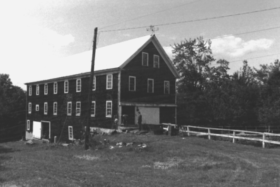 [104 Mills Road] The Clary Mill, built between 1893 and 1897, is the last surviving example of a building connected to the milling tradition in Whitefield, and by extension to the region’s lumbering industry. Originally known as Ballstown, Whitefield was settled in 1770. The first saw mills were built on the Sheepscot River at what came to be called King’s Mills. At least 12 mill sites existed along this twelve mile stretch of the river. The four primary mill sites were at Cooper’s Mills, the base of Grand Army Hill (Turner’s Mills), King’s Mill, and Clary Lake Mill. Each of these locations had multiple mills, and with the exception of King’s Mills, at least two dams.
[104 Mills Road] The Clary Mill, built between 1893 and 1897, is the last surviving example of a building connected to the milling tradition in Whitefield, and by extension to the region’s lumbering industry. Originally known as Ballstown, Whitefield was settled in 1770. The first saw mills were built on the Sheepscot River at what came to be called King’s Mills. At least 12 mill sites existed along this twelve mile stretch of the river. The four primary mill sites were at Cooper’s Mills, the base of Grand Army Hill (Turner’s Mills), King’s Mill, and Clary Lake Mill. Each of these locations had multiple mills, and with the exception of King’s Mills, at least two dams.
 The Sheepscot River flows from north to south through Whitefield, which is divided into several settlements, each located along the course of the river. In the far north is Cooper’s Mills, then North Whitefield, and in the south, King’s Mills. The availability of water power was a significant factor in the development of this otherwise agricultural community.
The Sheepscot River flows from north to south through Whitefield, which is divided into several settlements, each located along the course of the river. In the far north is Cooper’s Mills, then North Whitefield, and in the south, King’s Mills. The availability of water power was a significant factor in the development of this otherwise agricultural community.
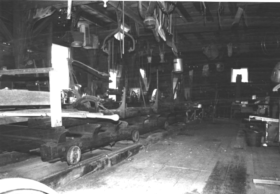 With the need to clear land, and a wealth of lumber that could be converted into cash, the development of saw mills was vital to the early success of Maine’s inland towns. In many, sawmills were the first frame structures built, preceding houses or public buildings. Because sawmills had helped lead the way into the “eastern frontier,” they exerted a substantial influence on early community development by providing lumber for local construction, forming a basis for local and regional trade, offering work for laborers, sawyers, and farmers, and providing an incentive to commercial development and investment.* [Christi A. Mitchell photos, 2004]
With the need to clear land, and a wealth of lumber that could be converted into cash, the development of saw mills was vital to the early success of Maine’s inland towns. In many, sawmills were the first frame structures built, preceding houses or public buildings. Because sawmills had helped lead the way into the “eastern frontier,” they exerted a substantial influence on early community development by providing lumber for local construction, forming a basis for local and regional trade, offering work for laborers, sawyers, and farmers, and providing an incentive to commercial development and investment.* [Christi A. Mitchell photos, 2004]
St. Denis Catholic Church
[west of North Whitefield on Maine Route 218 North Whitefield] St. Denis Catholic is the second oldest Catholic church in the state and the third oldest in New England. It was originally a wooden frame structure, thirty-six feet by fifty feet, built in 1818 by a spirited young Irish pastor, the Rev. Dennis Ryan, the first priest ordained in New England and Maine’s first resident parish priest.
As Maine’s population grew, Father Ryan drew many Irish immigrants to this farming community, making it the rural Catholic center of Maine. By the early 1830’s the community had outgrown the little church and replaced it with the existing brick building.
The new church was built around the wooden chapel. When the brick shell had been completed chapel was taken down. The new St. Denis Catholic Church was dedicated in 1833; the stone rectory was added in 1851. The bell tower was added in 1861 to replace the original roof-top belfry. [See photo above near the top]
Whitefield Union Hall, Whitefield, 1900-1956
Kings Mills is one of the three villages that comprise the Lincoln County town of Whitefield. Formed into the Town of Whitefield in 1809, each of the villages retained it separate identity, and functioned essentially as self-sufficient entities well into the 20th century. The Whitefield Union Hall, built in 1900, is a key element in the social history of Kings Mills. The Queen Anne Style building was built through the combined forces of the Whitefield Grange # 101, and the Whitefield Fish and Game Club, and served as the meeting place of each of these civic minded fraternal organizations.
As the only stage and hall in the southern portion of Whitefield prior to 1919, Union Hall was also the location of public dances, dinners and other events. Even as today’s residents identify less and less with the village than with the entire town, the Union Hall has continued to be a focal point for community gatherings and it is one of the last functioning remnants of the village’s independent identity. The Whitefield Union Hall was listed in the National Register for its contributions to the social and cultural history of Whitefield for over 100 years.
[See another view of the Union Hall above near top.]


